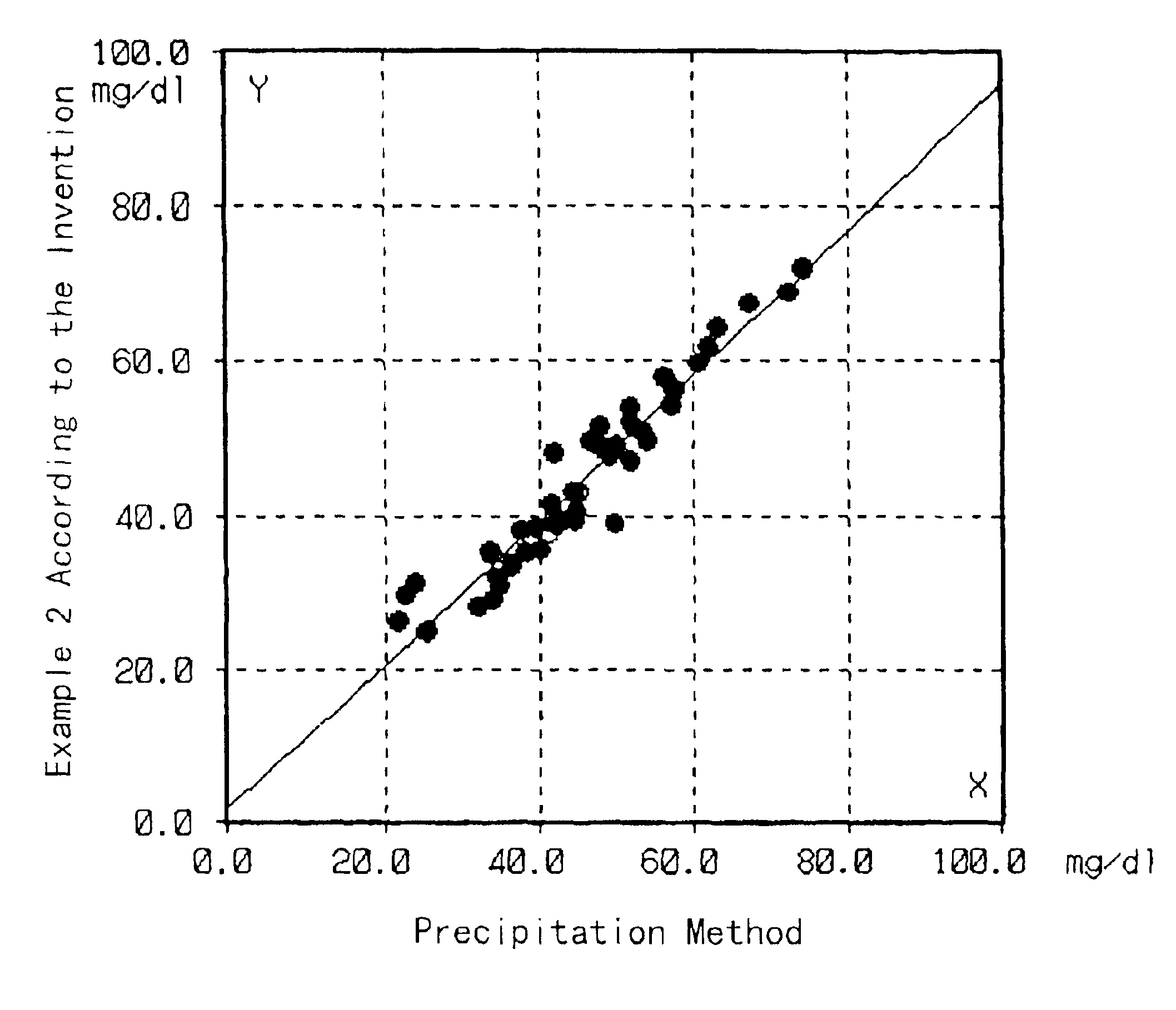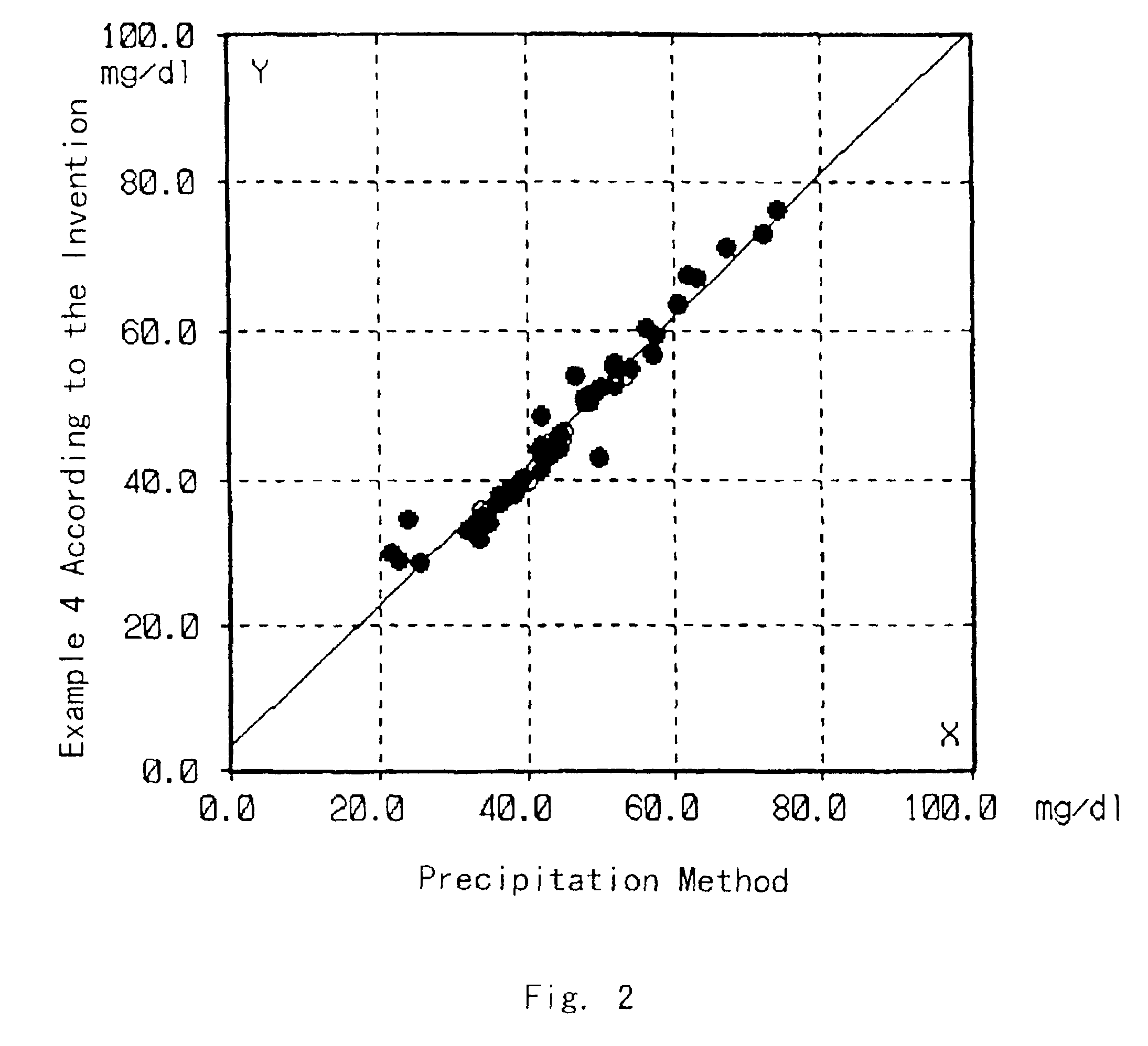Method for quantifying cholesterol in high density lipoprotein
a high density lipoprotein and cholesterol technology, applied in the field of cholesterol quantification in high density lipoprotein, can solve the problems of insufficiently simple methods, difficult specificities, and inability to meet the needs of patients,
- Summary
- Abstract
- Description
- Claims
- Application Information
AI Technical Summary
Benefits of technology
Problems solved by technology
Method used
Image
Examples
reference example 1
[0032]Using samples containing known amounts of purified HDL, LDL, VLDL and CM, respectively, the cholesterol in each of the lipoproteins was enzymatically quantified in the presence of a nonionic surfactant Emulgen 911 (polyoxyethylene nonyl ether, HLB 13.7), Emulgen B66 (polyoxyethylene derivative, HLB 13.2) or a mixture of Emulgen B66 and Emulgen A90 (polyoxyethylene derivative, HLB 14.5), all of which are commercially available from KAO CORPORATION. This operation was carried out as follows.
[0033]To a solution containing 0.5 U / ml cholesterol esterase, 0.4 U / ml cholesterol oxidase, 0.5 U / ml peroxidase, 1.0 mmol / l 4-aminoantipyrine and 0.5 mmol / l HDAOS in 50 mM PIPES buffer, pH 7.0, Emulgen 911 or Emulgen B66 was added to a concentration of 0.1% by weight, or Emulgen B66 / Emulgen A90 mixture (9 / 1) was added to a concentration of 1.3% by weight. Twenty microliters of each sample was mixed with 2.0 ml of the thus prepared mixture and the resulting mixture was allowed to react at 37° ...
example 1
[0036]First reagents and second reagents having the following compositions, respectively, were prepared.
[0037]
First ReagentsPIPES buffer, pH 7.0100mmol / lHDAOS0.7mmol / lCholesterol esterase0.8U / mlCholesterol oxidase0.5U / mlCatalase80U / mlMagnesium chloride10mmol / lSecond ReagentsPIPES buffer, pH 7.0100mmol / l4-aminoantipyrine4.0mmol / lPeroxidase2.4U / mlSodium azide0.1% Emulgen B66 (HLB13.2) commercially0.3% available from KAO CORPORATION
[0038]To each of 4 samples having a volume of 4 μl containing purified HDL, LDL, VLDL and CM at a concentration of 100 mg / dl, respectively, 300 μl of the above-described first reagents which had been preliminarily warmed at 37° C. were added and each of the resulting mixtures was allowed to react at 37° C. for 5 minutes. Thereafter, 100 μl of the second reagents were added to each mixture and each of the resultants was allowed to react for 5 minutes, followed by measurement of absorbance of each reaction mixture at 600 nm. Based on the measured absorbances, ...
example 2
[0042]Cholesterol in HDL in test samples was quantified by the same method as in Example 1 except that the test samples were sera of normal individuals. On the other hand, the HDL cholesterol in the same test samples was quantified by the precipitation method described in “Clinical Tests”, 23, 121 (1979). The correlation between the results obtained by these methods is shown in FIG. 1.
[0043]As shown in FIG. 1, the results of the quantification by these methods well matched, so that it was proved that the cholesterol in HDL can be accurately quantified by the method of the present invention.
PUM
 Login to View More
Login to View More Abstract
Description
Claims
Application Information
 Login to View More
Login to View More - R&D
- Intellectual Property
- Life Sciences
- Materials
- Tech Scout
- Unparalleled Data Quality
- Higher Quality Content
- 60% Fewer Hallucinations
Browse by: Latest US Patents, China's latest patents, Technical Efficacy Thesaurus, Application Domain, Technology Topic, Popular Technical Reports.
© 2025 PatSnap. All rights reserved.Legal|Privacy policy|Modern Slavery Act Transparency Statement|Sitemap|About US| Contact US: help@patsnap.com



